The Second Coming
Turning and turning in the widening gyre
The falcon cannot hear the falconer;
Things fall apart; the centre cannot hold;
Mere anarchy is loosed upon the world,
The blood-dimmed tide is loosed, and everywhere
The ceremony of innocence is drowned;
The best lack all conviction, while the worst
Are full of passionate intensity.
Surely some revelation is at hand;
Surely the Second Coming is at hand.
The Second Coming! Hardly are those words out
When a vast image out of Spiritus Mundi
Troubles my sight: somewhere in sands of the desert
A shape with lion body and the head of a man,
A gaze blank and pitiless as the sun,
Is moving its slow thighs, while all about it
Reel shadows of the indignant desert birds.
The darkness drops again; but now I know
That twenty centuries of stony sleep
Were vexed to nightmare by a rocking cradle,
And what rough beast, its hour come round at last,
Slouches towards Bethlehem to be born?
—W.B. Yeats, 1919
Follow the Falcon!
Best Practice Urban Design does not work in the North of Australia.1 The further north you get, the more this idea falls apart. The concept of “Best Practice” is generic, a strategy, that at its most successful is evidenced by convincingly rendering a place like somewhere else. The inadequacy of this goes unrecognized in most of the temperate climates of the world, but it screams out in protest in the extremity of the North. But it is going unheard.
The North West of Australia contains some of the oldest parts of the Earth’s crust, some of it over four billion years old, dating back to before the advent of oxygen. It is geographically remote, some 1200 km from the nearest capital city. The climate is extreme and volatile, with average summer temperatures exceeding 40°C.2 The wildlife is dangerous; bites and stings from snakes, jellyfish, and spiders can be lethal. Precious water is elusive; only people who have specific knowledge of the land can find it. For over 200 years it has been misunderstood as a strange and hostile place. Yet before European colonization, human life thrived up here for over 60,000 years.3
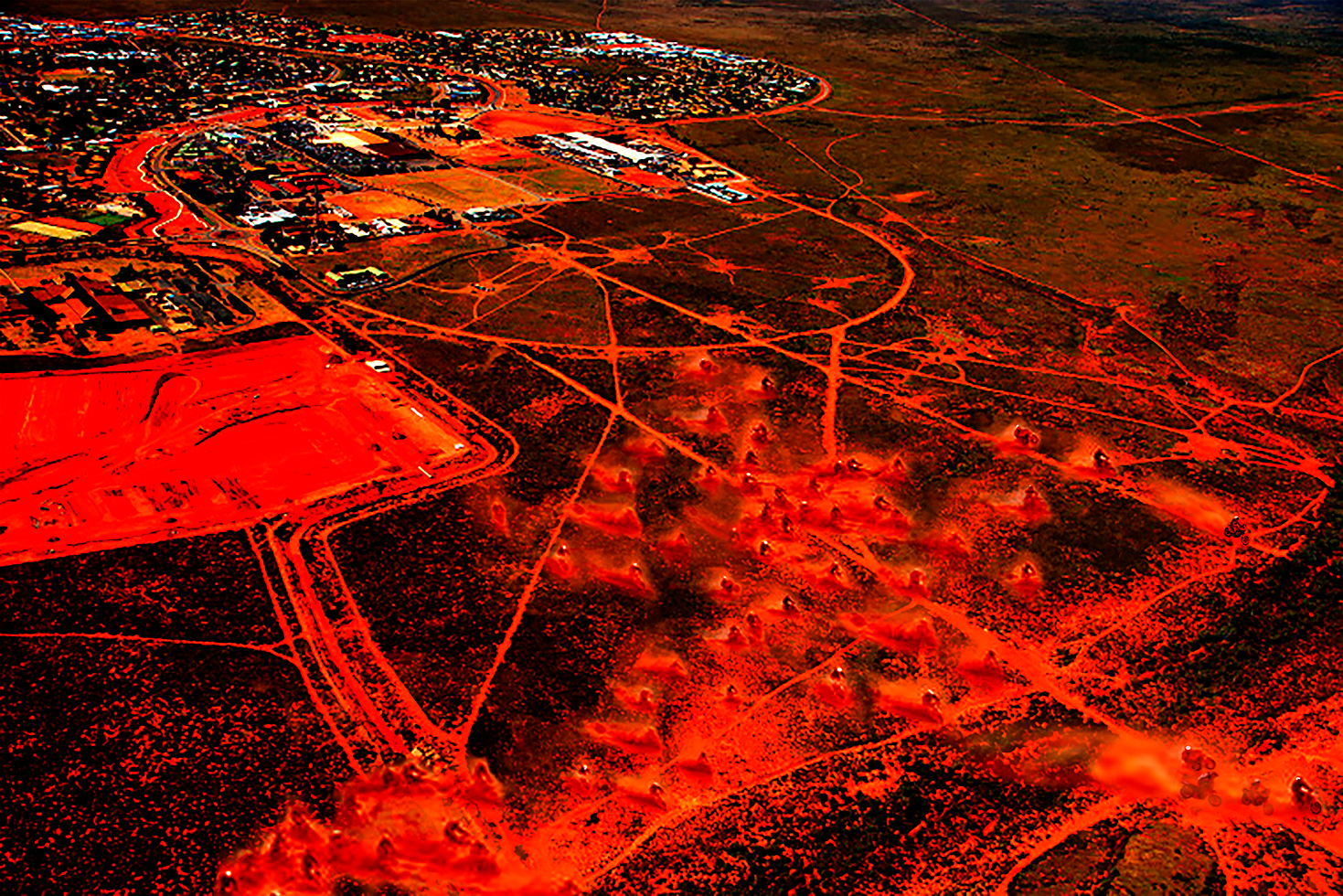
Australian urban planners have approached these extreme conditions with systematic denial. European suburbs were transported here, then piped with air-conditioning to enable the occupants to feel they were somewhere more hospitable. This is not to point the finger at the urban planners, more to pinpoint the limitations of Best Practice Urban Design to deal with the complexities of this climate. What if there was another way to see?
Turning and turning in the widening gyre
The falcon cannot hear the falconer;
Things fall apart; the centre cannot hold;
Mere anarchy is loosed upon the world,
William Yeats’ poem, “The Second Coming,” describes the uncertainties and anxieties inherent in the changing cultural-political climate of Europe post-first world war, articulating impending crisis. Australia now faces its own crisis; colonial maladaptation has put our unique ecosystem in peril.
In The Future Eaters, Tim Flannery states that “the question of adapting to Australian conditions has only recently taxed the minds of many Australians. For throughout the nineteenth century and well into the twentieth, Australians thought instead of ways to make Australia adapt to them. In its most extreme form, this view saw people attempting to create a second Britain in Australia.”5 Flannery asserts that this is “one of the saddest chapters in the history of this continent. For Australia’s ecology has floundered in the attempt.” Leon van Schaik articulates a similar sentiment but more specifically relates it to our colonial urban thinking; “Colonisation is a practice that is filled with the unconscious export of spatial (and not only spatial) histories and their attendant customs. Unthinking replication of spatial histories formed in Europe has wrought havoc on the ecosystems of Australia.”6 Contrary to Yeats’ intimation, anarchy has been caused by a fidelity to the center. What I am advocating for is not political, but spatial freedom.
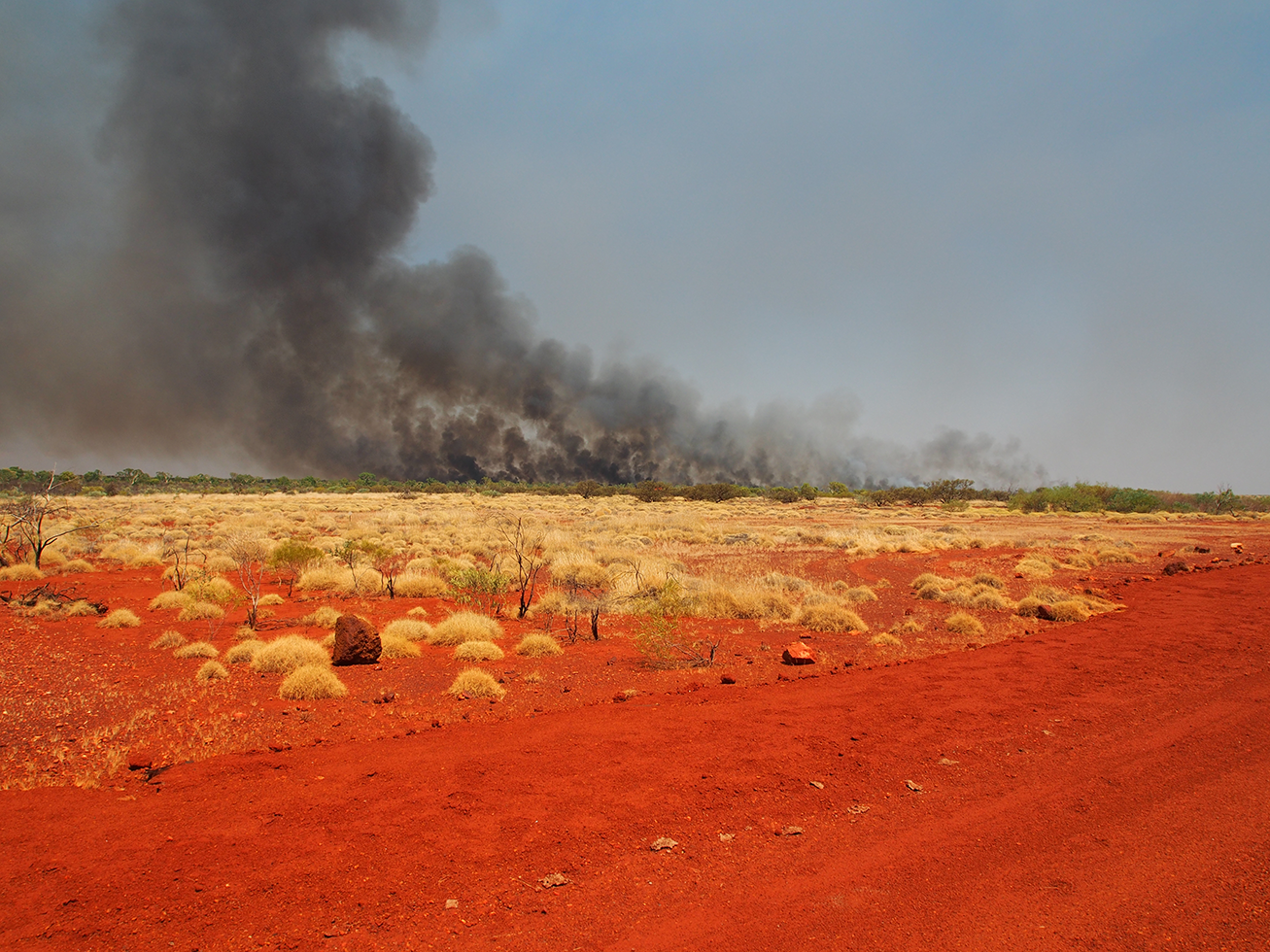
Surely some revelation is at hand;
Surely the Second Coming is at hand.
The shocking truth is that this is not a new or radical aspiration; in his book The Culture of Cities Lewis Mumford wrote about the great era of colonization “introducing a period of terrestrial neglect. In the act of seizing all the habitable parts of the Earth, the colonists of Africa and the Americas systematically misused and neglected their possession.”7 He goes on to say, “land values rose-and the land lost most of its value.” When Mumford published this in 1938, Australia could probably still have been saved.
Mumford poses that genuine planning would ideally be “an attempt, not arbitrarily to displace reality, but to clarify it and to grasp firmly all the elements necessary to bring the geographic and economic facts in harmony with human purposes.”8
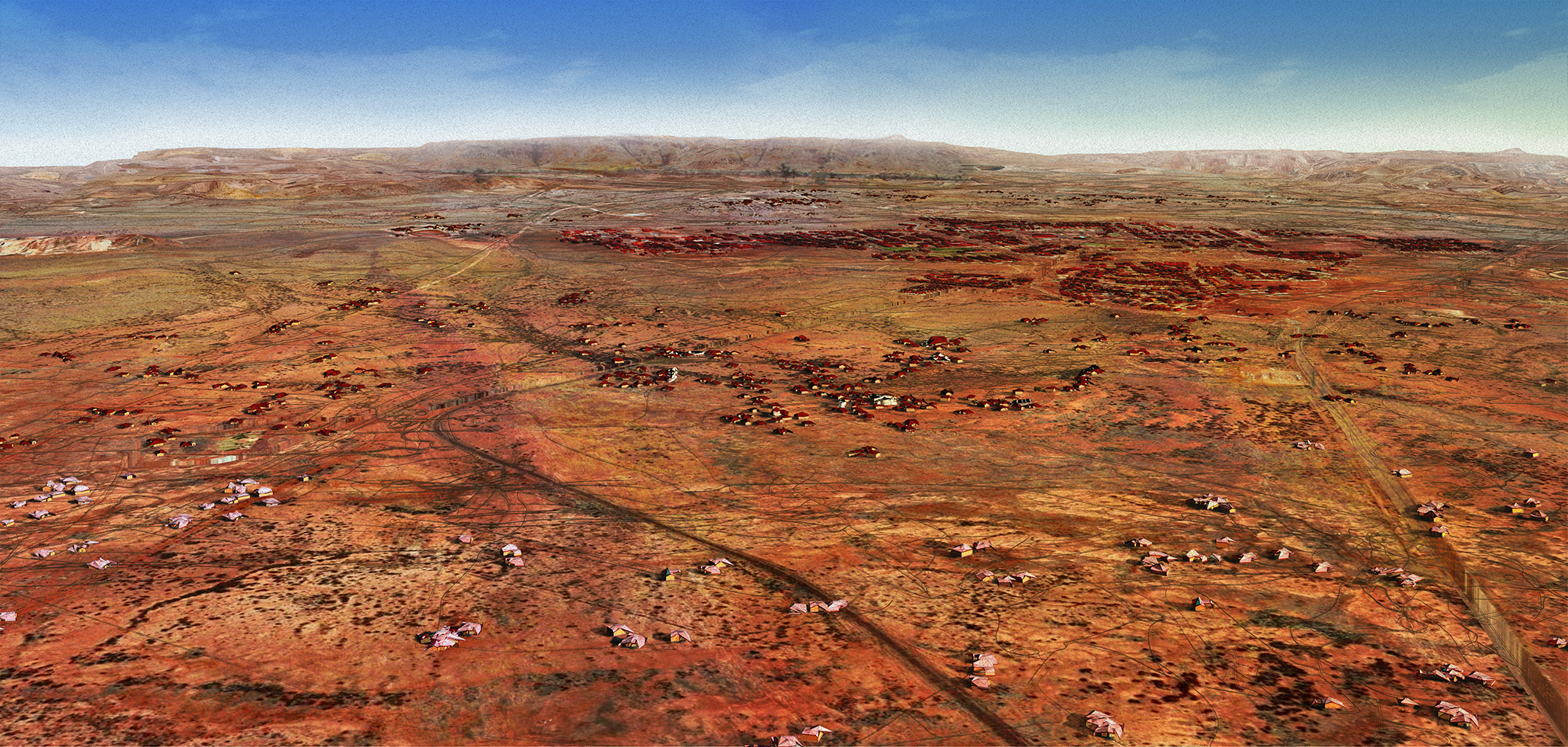
The Second Coming!
Hardly are those words out
When a vast image out of Spiritus Mundi
Troubles my sight:
somewhere in sands of the desert
A shape with lion body and the head of a man,
In 1938 Mumford challenged the value of the European suburb to address the specifics of the European climate and culture, let alone its suitability for somewhere as climactically different as the North of Australia. From 1967 onwards the Australian government systematically decided to displace reality and roll out the European suburb in the North; “somewhere in sands of the desert,/ A shape with lion body and the head of a man.”9
While it may seem a very specific example, I think these extreme towns reveal something valuable about our reliance on Global Best Practice. These extreme towns could be the clue that helps cities universally, testing our old values and the things we think we need.
The centre cannot hold.
Unable to come to terms with the strangeness of Australia, colonial urban design tethered itself to the Empire to maintain the illusion of stability and safety.
I would argue that, when it comes to urban design in Australia, the center cannot hold because the periphery is unstable. How do we respond to this perceived threat; do we keep circling, faithful to a lost signal, ignoring all our raptor instincts, to keep anarchy at bay? Will this work or will we fall from the sky, our efforts in vain? How many bad decisions have been made to avoid anarchy?
A gaze blank and pitiless as the sun,

Civic architecture has traditionally been a precinct of public spaces and buildings at the center of towns or cities. It offers opportunities for public demonstrations of power, success, and sovereignty. This may have worked historically in Europe, but it does not work in the North of Australia, where maladapted civic centers have attracted crime and violence. To add insult to injury, to address this problem, the Government has invested billions of dollars from mining royalties, into their revitalization. They have produced compelling reports illustrated with lush green walkable town squares and tree-lined boulevards. These reports are produced by planning departments thousands of kilometers from these remote towns. They are compiled with the best intentions after diligent research into best practice European urban design. These proposals are approved and built and then opened with great ceremony. After the tape has been snipped and the press photographs were taken, these town squares, with cleared areas of banded iron ground, walled by an army of fenced houses, will conduct and bounce heat around like a giant frying pan. You are now more vulnerable in the town center than almost anywhere else. Herein lies the dreadful truth, that we continue to make this place inhospitable. It is not inhospitable if you respond appropriately; if you redefine the civic.
Reel shadows of the indignant desert birds.
Urban design that increases walkability and reduces car dependence is an exemplar of “Global Best Practice,” and it is being rolled out generically worldwide. But in the North of Australia, the car is king. The extreme isolation and climate make the car essential for survival, and that fundamentally changes the way you live in and move around the city. Walkability is not only unsustainable in the North; it makes prey of those of us without the knowledge to survive.10
Roads are one of the first things that are designed and constructed in new towns and cities. I would argue this is one of the greatest flaws of contemporary urban design. In the North there is a real opportunity to challenge this; do we even need roads? The cars certainly don’t need the roads, the ground up here is harder than asphalt, in some parts it is up to 70 percent iron ore. Tire tracks throughout the towns and desert confirm that the roads are there as a suggestion only, most people drive wherever they want. On a visit up North, one local said to me gleefully, “You don’t need a driver’s license if you don’t drive on the roads!”
Things fall apart; the centre cannot hold;
So, if we break from the orbit of Europe, and we challenge the appropriateness of Best Practice urban design to suit our climate, will there be anarchy? If we don’t build tree-lined streets and town squares for people to bicycle through with fresh baguettes, will things fall apart? No. Not if we awaken our own intelligence and imagination and, as Tim Flannery puts it, try “to understand the nuts and bolts workings” of our land.11
And what rough beast, its hour come round at last,
Slouches towards Bethlehem to be born?
I propose an alternative ending to Yeats’ pessimistic warning of anarchy and menacing beasts once the center has been lost. On losing the falconer’s signal, what if the falcon remembers she is an elite predator, more adapted to survival than the falconer; she is the fastest animal on Earth and has the most acute eyesight. I think we will find not anarchy away from the center, but answers. I think we follow the falcon out of the center and then risk-manage the hell out of the situation until we see the glimmers of a new civic emerge; a civic that is signaled from the life force of this place. This new civic will give us spatial and spiritual freedom that will connect us to our country.
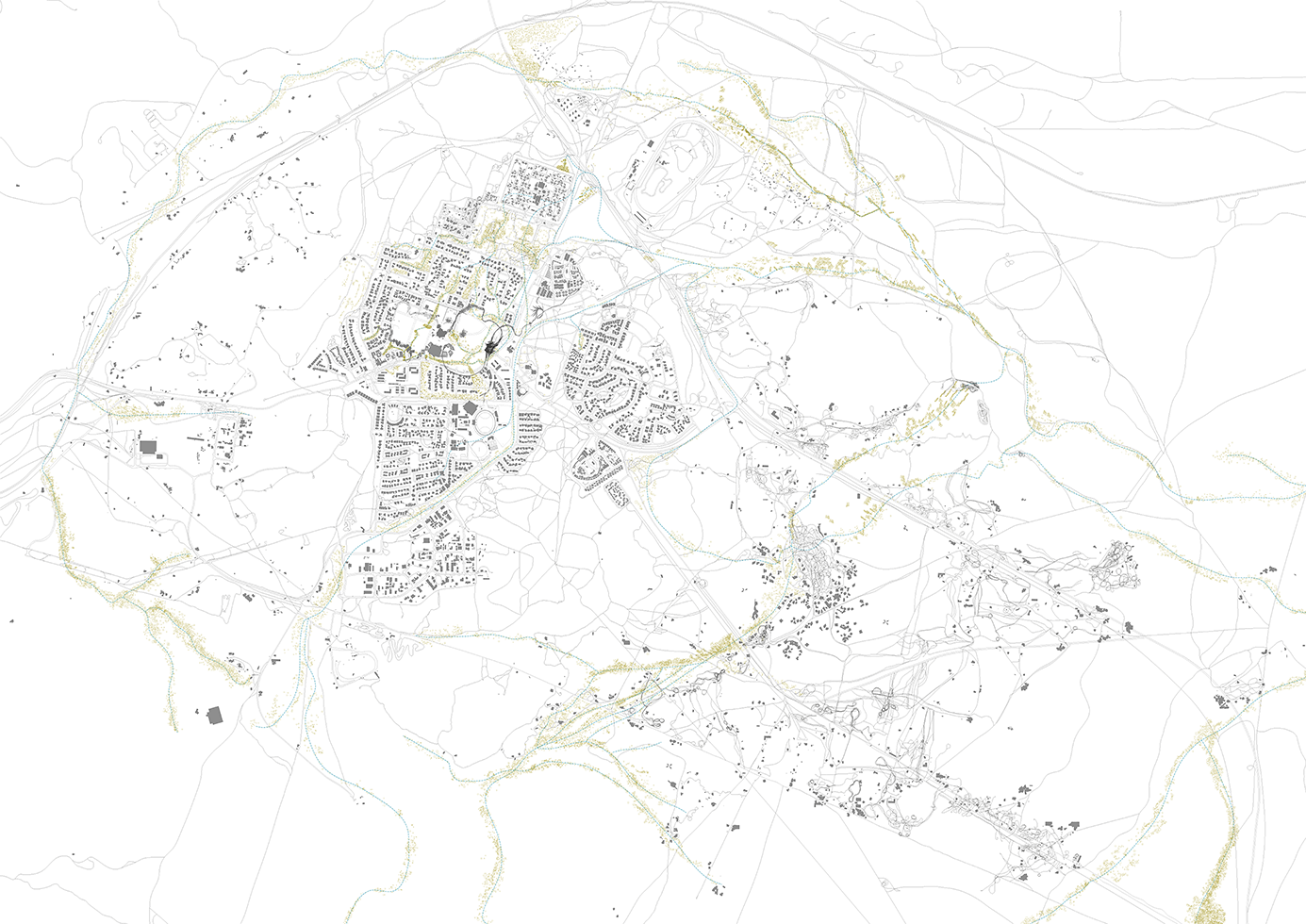
If we follow the falcon out, up, and around, we will get a broader peripheral view. From this height, you can examine the things people have done to adapt their surroundings to work in this climate. These are the clues. They are abundant. What behavior does thrive here, where is the existing civic happening that we are just not recognizing?
Close inspection via satellite imagery of the ground around these isolated towns reveals a new domain for the civic. It is not found in the center of the town but out in the desert—this is where people congregate. After work and on weekends, people get on motorbikes and drive straight from their back yards into the desert. Low vegetation means you can see this ancient part of the planet all the way to the horizon; it feels like you are occupying all time, past, present, and future.

Turning and turning in the widening gyre
Motorbikes inscribe the desert with a geometry of joy; doughies that circumscribe infinite centers.12 What if we accept these roads in the desert as the real roads, and let them lead us to the new civic? These are better roads than any traffic engineer could design!
Mere anarchy is loosed upon the world,
It serves me to interpret Yeats’ use of “mere” to undermine anarchy and to question the scale of its threat. What if “mere anarchy” is the answer? With falcon eyes, I find these little anarchies throughout the grid of these northern towns. Areas where the people have broken down the maladapted suburb they were given, to make it better fit the climate and culture. From an aerial view, the falcon’s eye can see a vast network of owner-built sheds and lean-tos that span between every house and fence. This is where the civic actually happens in the North. In these sheds, you will find outdoor spas, bars, games rooms, televisions, metal workshops, lounges, BBQ areas. This is what people want to do together. The civic spaces that have been provided for them by the government are a built reminder that things are falling apart; the center cannot hold. The civic spaces they build themselves connect them to something much more valuable—this country, and this community—on their own terms. Protected outdoor spaces that celebrate the mild temperatures in the evenings, the extraordinary sunsets, often with electrical sky shows, and on clear nights, a black canopy so full of stars and planets, it makes the Earth feel small. This is what you see away from the center: little anarchies that undermine it.
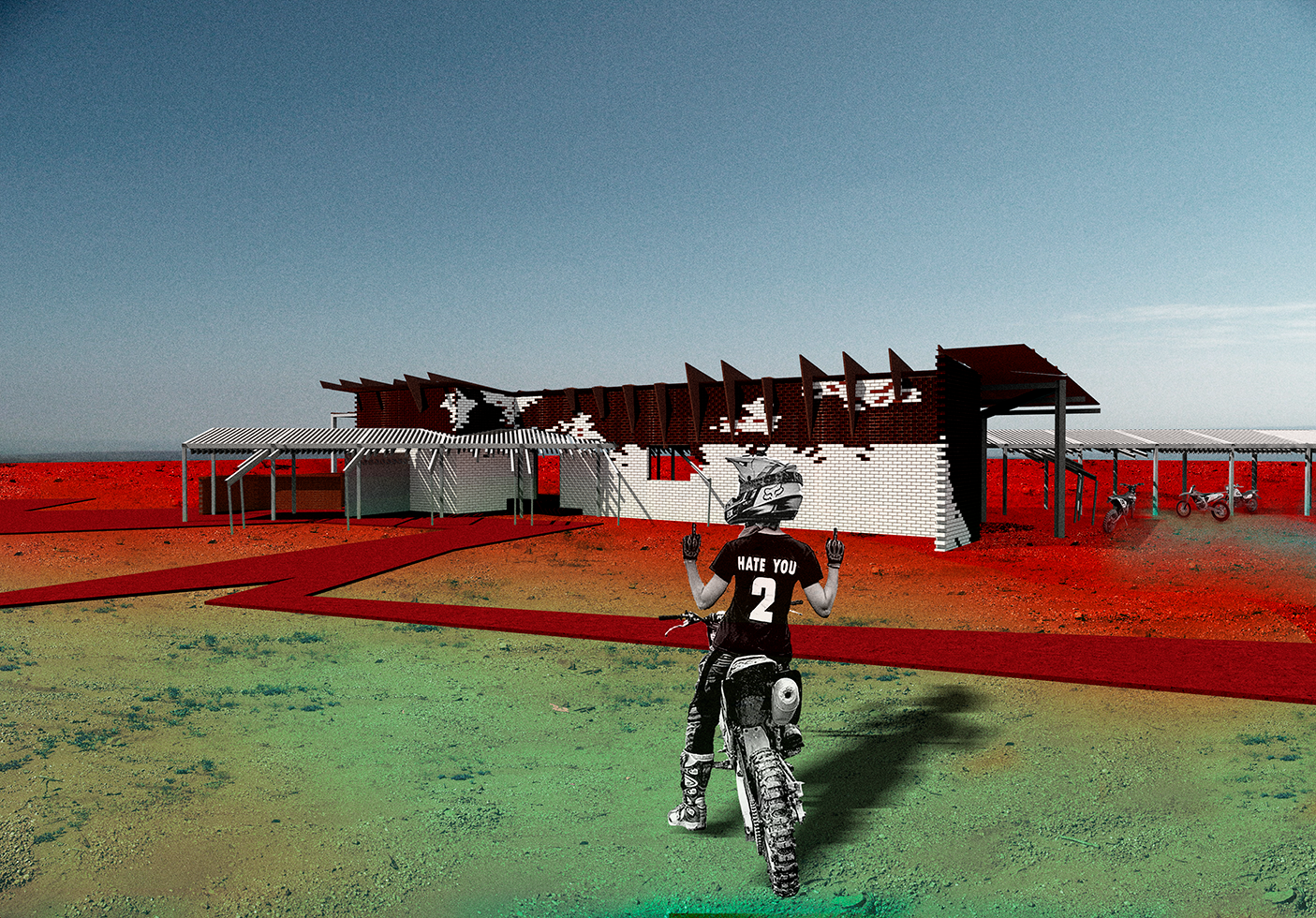

So how do we capture this, this new idea of civic that celebrates the land and not the urban past? What if we fuse the two things together, the motorbikes and the open sheds, out in the desert? It makes sense of this incredible place. It acknowledges what an extraordinary part of the planet they are on, and does not try to smother its idiosyncrasies with old ideas that belong to somewhere else.
The design strategy is to pull these sheds out of the center of town, and towards areas of geological significance. This enables people to connect with a more meaningful civic, a prehistoric cultural civic. This civic could put us into a relationship not just with the present, but with deep time—perceived not in decades or centuries, but in geological eras.
Maintaining an attachment to the center has limited the quality of our experience on this planet and, as a consequence, we (and our planet) are now more isolated and vulnerable than ever. But our cities are still being planned around old fears and old values. This article questions the relevancy of Best Practice Urban Design in the North of Australia specifically but, given this planet’s shrinking biodiversity, one has to ask: is it working anywhere? There is no universal civic that can be appropriated at all latitudes.
If we stop forcing the acceptance of ideas of the civic on these places, something much more interesting will emerge, that challenges the way we live everywhere. It is time to find the many civics that celebrate the specifics and complexities of a place. We could legislate differently to recognize biodiversity and distinctive systems of order. This would allow creative minds to collectively contribute to what Mumford calls “genuine planning,” which responds to the unique culture, climate, and geology of a place.
Forget the center with its town square, roads, and walkability. Accept the car and the motorbike. The civic can be outside of the city. The civic can connect you to something greater, not the greatness of your own human-centered culture, but the greatness of this planet. It is happening anyway, we are just not acknowledging and building for it.
The ceremony of innocence has drowned. If we can acknowledge this, then there may still be time for the best to summon their conviction, discover their passionate intensity, and with all the prowess and gut-cunning of a falcon, keep the slouching beasts away.
Emma Jackson is a lecturer at RMIT Architecture and Urban Design in Melbourne and recently completed her PhD, “Everywhen, Dirty Algorithms to Agitate a More Appropriate Occupation of Australia.” Her work has exhibited at the CITYX Venice Virtual Pavilion at the 17th Venice Architecture Biennale. She is the founder of Ground Under Repair, a creative practice that recently won the 2021 Tapestry Design Prize for Architects, an international large scale public art design award.